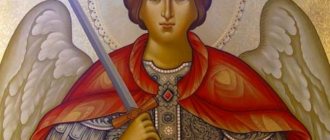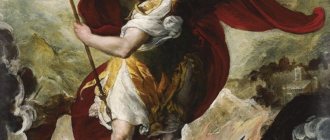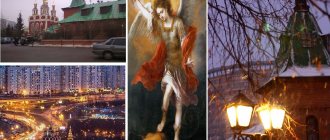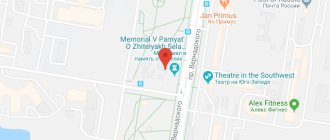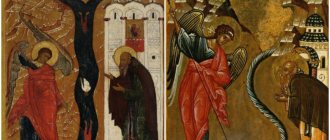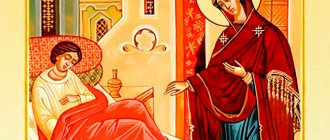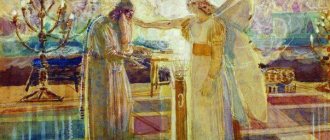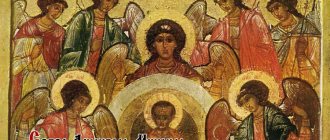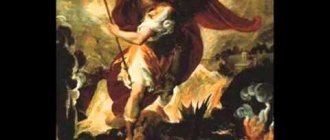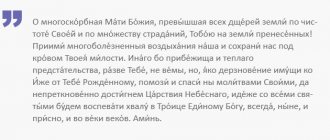We don't think about them during working hours, but that doesn't mean they don't exist. The upper world also has its inhabitants, even if they cannot be seen. They exist; Holy Scripture itself often mentions this. In several classifications compiled by priests, a special place among the heavenly inhabitants is occupied by archangels - one of the highest categories of angels, carrying out special orders from God. Among the creatures endowed with superhuman strength is one of the commanders of the angelic army, whose image is depicted on the shrine - the icon of Archangel Michael.
Memorial Days:
- September 19 – Remembrance of the miracle in Khoneh;
- November 21 – Cathedral
The most famous place of pilgrimage in Europe is considered to be the French monastery-fortress of St. Michael near Normandy and the cave church in Italy - Monte Gargano. However, not only in Catholic churches is the icon of the Archangel Michael known; in Moscow, the miraculous shrine is located in the Church of the Archangel Michael, in Troparevo, which was erected in honor of the saint in 1693-1694.
Archangel of the Heavenly Hosts
Iconography: Michael, Archangel Dates: 16th century. Beginning of the 16th century. Origin: From the Padchevar Church of the Archangel Michael, Kirillovsky district, Novgorod province. Material: Wood, tempera. Dimensions of the icon: height 91 cm, width 32.5 cm From the Deesis tier of the iconostasis. Full-length image of Archangel Michael in a three-quarter turn. NGOMZ 11164. © Novgorod State United Museum-Reserve Literature: Icons of Veliky Novgorod of the 11th - early 16th centuries. The authors of the project are L.V. Nersesyan and S.V. Obukh. M. Northern pilgrim. 2008. No. 102.
Everything created by the Lord is divided into visible and invisible existence - the material and spiritual world. The latter includes angels or disembodied forces - the “heavenly army”; the Archangel Michael is considered the Archangel or military leader (from the Greek Αρχιστρατηγός).
For the first time, an attempt to understand the relationships in the angelic community was made in the work of Dionysius the Areopagite “On the Heavenly Hierarchy”, according to which the world of invisible light spirits has a triadic structure, and the angels themselves play a mediating role between God and man. According to Dionysius, Archangels belong to the penultimate, eighth of nine possible angelic ranks. The author of the treatise explains by this provision their special closeness to people.
Useful materials
The canonical books of the Holy Scriptures mention Michael in his Archangelic capacity. In addition to him, the Holy Tradition, which includes liturgical texts and various kinds of hymnography, brings to us the names of other Archangels of God.
The name Michael, translated from Hebrew, means “Who is like God?” (mi ka el), this name is connected with the legend of the war with Dennitsa, an angel who, having become proud, fell away from the Lord and, in his madness, decided to fight against Him. In the heavenly army there was then an Archangel who exclaimed: “Who is like God?” (in the sense of “who can compare?”), carried many angels into battle and won.
Iconography: Michael, Archangel Dates: 20th century. 1904 Icon painter: Kubrin Mikhail (?) Trofimovich Material: Wood, tempera, gilding. Dimensions of the icon: height 22 cm, width 27 cm, the Archangel is depicted full-length, in military garb, holding a shield in his left hand and a fiery sword in his right. © Omsk Regional Museum of Fine Arts named after M.A. Vrubel
According to the interpretation of the holy fathers of the Church, it is Archangel Michael who, with a fiery sword in his hands, guards the gates of Paradise. In his military form, his name is mentioned on the pages of the Old Testament and the book of the Apocalypse of St. John the Theologian:
“And there was war in heaven: Michael and his angels fought against the dragon, and the dragon and his angels fought against them, but they did not stand, and there was no longer a place for them in heaven. And the great dragon was cast out, that ancient serpent, called the devil and Satan...” (Rev 12:7-9).
In Orthodoxy and some other faiths, he is considered the “posthumous” patron and protector of people at the Last Judgment. They pray to him to protect the soul of the deceased from the forces of evil.
Description of the holy image
The Bible does not clearly indicate when exactly the Angels were created, but most of the holy fathers indicate that they appeared before Adam, as representatives of the spiritual sphere. Being incorporeal beings, angels have something in common with humans - free will. Only, unlike humans, angels are unable to betray God if they have once chosen obedience. They can also become visible to people in order to convey God's will to them.
Work as a courier at Yandex.Eda (up to 3,400 rubles per shift) leave a request →
How did people dare to depict something that is invisible to their eyes and incomprehensible to their minds? God Himself gave the blessing for the depiction of heavenly creatures back in the Old Testament; this is a very ancient tradition. The images of angels are not portraits, but symbolic representations of their nature and abilities.
According to Blessed Theodoret, angels appear to people in a form that they are able to perceive and not be afraid. But the appearance should also indicate that the person is facing God’s messenger. The heavenly inhabitants are represented in similar ways in the images. You can recognize the icon of Archangel Michael by the description of the main angelic attributes:
- wings - symbolize speed, the ability to penetrate through space;
- halo - holiness;
- dolmatica (mantle) - blue or white, sometimes gold;
- himation (cloak) - red;
- staff - indicates the role of a messenger;
- toroka (ribbon used to tie hair) - a sign of obedience to the Lord;
- the appearance of a handsome young man speaks of the perfection of angelic nature.
There is also a mirror that Archangel Michael can hold in his hands - this is a sign of foresight. If in doubt, any icon can always be identified by its name, which is written next to the image, above or below it.
Iconography
According to the established icon-painting tradition, which largely repeats legend and hagiographic literature, archangels can be depicted in military vestments: armor, a chiton and a cloak with a “tavlion” (a diamond-shaped sign embroidered with gold, indicating a high position). In eastern temples, angelic images in Byzantine court clothes, the so-called “lorat” - dalmatics and laura, were common.
Iconography: Michael, Archangel Dates: 16th century. 1592. Material: Wood, gesso, tempera. Dimensions of the icon: height 197 cm, width 66.5 cm Archangel Michael is depicted full-length, in a three-quarter turn. The chiton is greenish, the himation is scarlet, the wings are brownish. There is a dotted pattern along the edge of the halo (imitation of a pearl edge). The face is painted on a darker sankir, with a soft swirl. The background is light ocher. Inv. No. KXM KP 02062. © Kostroma State Historical, Architectural and Art Museum-Reserve
At the Seventh Ecumenical Council, it was decided to paint the ethereal heavenly powers in the now classic, iconic robes - tunics and himations (see the angels of St. Andrei Rublev).
There are many variations of the iconography of Archangel Michael in military armor. As a rule, they come from the Old Testament story about the miraculous “Appearance of the Archangel Michael to Joshua” - a mysterious man dressed in armor appeared to the leader of a large Jewish army. He not only inspired the Jewish military leader, who was at a loss before the impregnable stronghold, but also taught him how to break the resistance of the fortified city of Jericho.
In the most traditional version of the account, “Michael the Official,” dressed like a warrior, holds a sword in his hand, and Joshua kneels in front of him, untying the straps on his shoes. This is exactly how “Erminia” (an ancient reference book on iconography) describes this plot; she also identifies it as a separate iconographic line. In Rus', this iconography has been known since pre-Mongol times. In the Assumption Cathedral of the Moscow Kremlin there is an icon of the “Appearance of the Archangel,” dating back to the twelfth century.
Interesting fact
They liked to depict the Old Testament story of the victory over Jericho on military banners. These were the banners of Dmitry Pozharsky and Grand Duke Vasily the Third.
Images along with arch. Gabriel
Iconography: Michael, Archangel Dates: XIV century. 1387–1395. Icon painting school or art center: Constantinople. Origin: From the Church of the Conception of the Virgin Mary of the Vysotsky Monastery in Serpukhov, where they were sent in the 1380-1390s from Constantinople. Material: Wood, tempera. Dimensions of the icon: height 147 cm, width 104 cm The image is half-length, the figure is facing to the right. The Archangel slightly bows his head, gestures with his right hand to the Savior, and with his left hand, as if leaning on him, squeezes a bright red staff-measure. Inv. No. 12730. © State Tretyakov Gallery, Moscow Literature: State Tretyakov Gallery. Collection catalogue. Old Russian art of the 10th - early 15th centuries. Volume I. No. 74.
The inclusion of the pair of Archangel Michael and Archangel Gabriel in the icon composition was common in Byzantine and Russian icon painting. In Rus', this double image probably originates from the so-called “Angelic Deesis” - an ancient icon, most likely from the pre-Mongol period. The image survived and continues to exist in the Tretyakov Gallery.
Iconography: Cathedral of the Archangels Dates: XIII century. Second half of the 13th century. Origin: From the Archangel Michael Monastery in Veliky Ustyug. Material: Wood, tempera. Dimensions of the icon: height 165 cm, width 118 cm. The icon depicts the archangels Michael and Gabriel in full view, holding a tondo with the face of Christ Emmanuel. Inv. No. DRZh-3103. © Russian Museum, St. Petersburg, 2011
The word "Deesis" comes from the Greek. “deisis” is a prayer, a special plot representing the Mother of God, angels or saints in a state of prayer before God, as well as the central row of icons of the traditional iconostasis. This triadic icon is like a truncated “shoulder-shaped” Deesis row, with the Savior-Emmanuel in the center and the archangels on the left and right sides. There is an opinion, unrecognized in church and scientific circles, that this may be one of the types of icons of the Holy Trinity.
"Cathedral of the Archangel"
Another common version contains the figures of eight archangels - this is the iconography of the holiday “The Cathedral of the Archangel Michael (And other ethereal heavenly powers).”
Iconography: Cathedral of the Archangel Michael Dates: XVI century. Material: Wood, tempera Icon dimensions: height 67.7 cm, width 54.4 cm Multi-figure composition dedicated to the unanimous glorification of God by the angels. The compositional center of the icon is the image of two angels holding in their hands above the throne a frontal half-length image of the Savior Emmanuel in round glory. In addition to the angels, the icon depicts the ranks of angels: seraphim and cherub.
“The Cathedral of Archangels” is a dynamic multi-figure composition built around the image of the Savior (or Savior-Emmanuel), the archangels are depicted in full growth, in their hands they hold small mirrors (translucent or blue-white spheres) with the name of the Lord Jesus Christ inscribed on them ( "IC" and "XC"). Angels can be written in the second row in the icon.
Another version of the iconography contains only images of Michael and Gabriel, also with mirrors, with the Savior-Emmanuel in the center and with the monogram of Christ or the Cross. Icons of this type are often found, made in an academic or semi-academic style. The paired image of angels seems to double the prayer power of the image, recalling the constant participation of disembodied forces in the affairs of God’s providence for the human race.
"Blessed are the hosts of the Heavenly King"
“Blessed are the armies of the Heavenly King.” Icon. Ser. XVI century (TG)
The Icon of the Heavenly Host (or “Blessed is the host of the Heavenly King”) was painted by order of Tsar Ivan Vasilyevich (IV) the Terrible for the Assumption Cathedral of the Kremlin, where it was kept in a special icon case, next to the royal place (since 1919 it has been in existence in the Tretyakov Gallery). Its name comes from a liturgical song text dedicated to the martyrs:
“Blessed is the army of the Heavenly King, even though earthly beings were passion-bearers, but having strived to achieve angelic dignity, they neglected bodies and received honor through disembodied suffering” (Octoechos, stichera of the V voice to the martyrs).
The procession of the holy army under the command of the “heavenly commander” Archangel Michael on a winged fiery horse is compositionally placed in the central part. The soldiers march in three rows, from the city blazing with fire (Sodom) to the virtuous city (Heavenly Jerusalem), standing on a mountain and crowned with a tent. The plot is taken from the book of the Apocalypse (Revelation) of John the Theologian, according to which the mountain with the “heavenly city” is, as it were, surrounded by a “pure river of the water of life” (Rev XXII, 1). In front of its fortress wall, the Virgin Mary and the Child Christ are presented, who hands the heavenly crowns of the winners to the angels. Angels flying towards the soldiers crown the righteous.
Perhaps this iconography quotes the letter of the Apostle Paul to the Jews: “... for we have no city abiding here, but in the city to come we will seek for ourselves the city” (Heb. XIII, 14). In part, it also echoes the liturgical texts of Octoechos, glorifying the martyrs, but the strongest connotations are with the Revelation of John the Theologian, containing not only a detailed description of the City of Heavenly Jerusalem, but also “sinful Sodom.” The plot also goes back to the book of the prophet Daniel and his eschatological vision of the “perishable kingdoms.”
Interestingly, many researchers believe that the icon was painted in honor of the capture of Kazan by the Russians in 1551. On the eve of the campaign, Metropolitan Macarius promised a kind of indulgence - forgiveness and remission of sins to all who participated in it and a martyr's crown to those who might give their lives for the Orthodox faith. The iconographic plan equated the feat of the dead with martyrdom, and the fallen warriors became part of the heavenly Church Militant.
Voivode of the formidable forces
Iconography: Archangel Michael of the formidable forces of the governor Dates: XIX century. Icon painting school or art center: Russia. Material: Wood, gesso, tempera. Dimensions of the icon: height 22 cm, width 27 cm The Archangel is depicted as the archangel of the Heavenly Forces riding on a horse in military garb. Two saints are depicted in the margins. Above him, at the top of the icon, is the Savior Emmanuel. © Omsk Regional Museum of Fine Arts named after M.A. Vrubel
Around the same time, the image of “Archangel Michael of the formidable forces of the governor” appeared in Rus'. On it the Archangel is depicted flying on a red winged horse.
This is the image of the Archangel - the protector of the person praying from visible and invisible enemies both in earthly life and after death. At the same time, it contains a symbolic reflection of the most important Christian dogmas - about the Eternal Council, about the incarnation of the Son of God, about the future Last Judgment.
Miracle in Khoneh
Iconography: Miracle of the Archangel Michael in Khoneh Dates: XVII century. Icon painting school or art center: Yaroslavl school Material: Wood, gesso, tempera. Dimensions of the icon: height 102 cm, width 94 cm Archangel Michael saves the church dedicated to him in Khoneh from destruction, blocking the waters from accessing the church. Archippus of Herotopus stands praying in front of the temple. I-893. © Yaroslavl Art Museum. Literature: Icons of Yaroslavl XIII - mid-XVII centuries. M., 2009. T. 2. Cat. No. 110.
The source of the iconography “The Miracle of the Archangel Michael in Khoni” was the well-known legend about the appearance of the Archangel and his miraculous help in the Greek city of Khoni (before these events - Colossae, to whose community the New Testament “Epistle to the Colossians” of the Apostle Paul was addressed). The plot became so significant that the Byzantine Church established a special festival, celebrated annually on September 6. It is based on the ancient “Tale of the Miracle at Khoneh”, as edited by Simeon Metaphrastus.
In Greek Colossae there was a well-known spring in the vicinity of the city, which opened after a visit to this place by the Apostle John the Theologian, who predicted the appearance of the Archangel Michael in this place. Its water had beneficial properties, and the miracles performed from it converted many pagans to Christianity. Thus, the mute daughter of a noble city dweller was miraculously healed, who poured water into the girl’s mouth, at the behest of the Archangel, who came to him in a dream vision. Grateful and amazed by the miracle, the father was baptized with his entire family and built a temple in the name of Michael at the shrine.
The monk who served at the monastery, Elder Archippus, was famous for his piety and wisdom. He took care of the healing spring and converted many to Christianity, which angered the local pagan community. One day, angry pagans came up with a way to destroy the temple along with the old man: they decided to unite two small rivers into one channel and, having built a dam, and then, breaking it, directed powerful streams towards the church.
Archippus learned about the evil plan, he prayed to Michael all the time while the work was going on, and when the stream of water was already rushing towards the temple, the Archangel appeared in front of the old man and told him to stand “at his right hand,” that is, to his right. Afterwards, Michael hit the rock with his staff, next to the altar - the stone moved apart, a mouth was formed, and, according to the word of the Archangel, water rushed to the ground. Michael promised the elder that this place would be holy forever. The pagans who saw the miracle fled, and Colossae received a new name - Khona (crack, crevice).
Iconography became very popular in Rus' from the end of the sixteenth century, a time that came with the heyday of monastic life, when strict asceticism became a high ideal. The feat of monasticism is especially exalted and glorified, which personifies the image of the elder Arkhippus, who showed all the power of monastic prayer in its ability to resist vice.
Appearance of the face
There are two main compositional options for the image of Michael: a half-length image and a full-length recreation of the angel’s figure. Regardless of the type, the celestial commander always looks the same.
In his right hand is a fiery glowing sword or spear with a cross at the end. Symbolically, a weapon means readiness to fight evil spirits (personified by Satan) and to protect people from it.
The Archangel is wrapped in a scarlet cloak (can be fastened on the left or right side). The cloak often develops backwards, which adds even more belligerence to Mikhail. Although there are also more peaceful versions of images.
The archangel on the icon must have chain mail and a shield, which symbolize strength, power and readiness to immediately perform military duty.
But this is not the whole meaning: the angel dressed in armor is called upon to resurrect in the memory of believers the event described in the Bible, when he came to the aid of Joshua.
Zvenigorod rank of St. Andrey Rublev
Archangel Michael. St. Andrey Rublev. Zvenigorod Deesis rite.
The famous Deesis icon of the Archangel Michael is an image of amazing beauty and power, painted by St. Andrei Rublev, belongs to the “Zvenigorod rank”. According to the Tretyakov Gallery legend, it was found in a barn at the Assumption Church in Zvenigorod, almost under a pile of firewood.
The composition, which was previously part of the iconostasis, is a half-length image of the Archangel in a prayer pose (deisis). The Archangel wears a chiton of heavenly azure color and a swirling pink cloak, painted with light transparent bleach. The image represents him not in a military, but in a prayerful hypostasis, as if immersed within himself, listening to God.
Interesting fact
The icon is one of the most revered monuments, standing on a par with such shrines as the Trinity, also belonging to the brush of St. Andrew.
Who are the archangels
Archangels have superhuman abilities and belong to one of the 9 angelic ranks. Their direct responsibility is to carry out the Lord’s instructions. The clergy puts forward theories that angels were created long before the material world. Each of them has its own personality and name. The most ancient creatures act as intermediaries between the earthly and heavenly worlds, and also convey the will of the Lord to mere mortals.
In the Orthodox world, the image of Archangel Michael is especially revered
Miraculous icon in Moscow: Archangel Michael with his deeds
Archangel Michael with his deeds. Archangel Cathedral of the Moscow Kremlin.
In the Archangel Cathedral of the Moscow Kremlin, a particularly revered icon of the Archangel with stamps exists. It is also dated to the end of the fourteenth, beginning of the fifteenth century, this rather voluminous composition 235.5 × 182.2 cm, with a very dynamic figure of an archangel depicted in the middle, in traditional military attire, with a sword in his hand. Eighteen marks along the perimeter of the composition contain scenes of miracles and apparitions of the archangel. One of the stamps depicts the plot of Abraham's hospitality, with three angels - better known as the Trinity.
The Archangel Cathedral is located on Cathedral Square of the Moscow Kremlin.
In the private collection of the St. Andrew the First-Created Foundation, in Moscow, there is a rare icon of the Archangel Michael “Loratny”, which is a monument of the fifteenth century.
Miracle of Flora and Laurel
Iconography: The Miracle of Flora and Laurel
Rus' had its own favorite folk icon - “The Miracle of the Archangel Michael about Flora and Laurel”; the image is of Balkan origin. The composition of the icon is three-tiered: in the center there is a life-size figure of the Archangel, in the middle part there are Saints Florus and Laurus, in the lower part there are multi-colored horses, white, red and black. Their reins are in the hands of Michael, who taught the saints to control horses.
Sacred tradition preserves the memory of the deeds of Archangel Michael and the many miracles performed by the angelic commander. The most famous:
- Miracle of the Archangel Michael in Khoneh.
- Plague in Rome.
- Rescue of Sipont.
- Rescue of a youth near Mount Athos.
- Rescue of the heir.
- Saving Novgorod.
- Archangel and Joan of Arc.
- Miracle of Flora and Laurel.
How and where to hang an icon
For your home, you can choose an icon of any size and the type that you like best, which will kindle love for the Lord in your heart. Many people wonder where to place the icon of Archangel Michael at home. The location does not play a fundamental role. The holy image is not a talisman or a magical thing; its purpose is to promote a prayerful mood.
If you want to light a lamp in a holy corner, you should purchase a special shelf. A small lamp is placed or hung in front of the icon, a special oil is poured into it - consecrated and without any foreign smell, it is worth purchasing it in a church shop. This oil will be safe and economical. According to tradition, it can be anointed at home after prayer, before a trip or important task, or during illness.
Since angels are special beings in the spiritual world, special prayers, akathists, and troparia are written to address them. They are read during church holidays. You can also say them at home or on the road. Only a few righteous people were honored to meet these creatures during their lifetime, but they are capable of hearing people and helping them. It is believed that by their bad deeds people can unwittingly drive away angels from themselves.
Many military personnel have an icon of the Archangel Michael in their homes, as he is considered their protector. He also patronizes those who defend the Christian faith. They turn to him in prayer during the construction of new churches and monasteries. A courageous heavenly warrior will help you emerge with honor from difficult life circumstances.
About the author About the book
Archangel Michael helps with prayers near the icon and in many other matters. Since the angelic ranks stand very firmly in their faith, they are able to save a person from doubts and spiritual tossing. You can also contact during times of strong temptation. Don’t be shy - they come to all people, but pride (“nothing can help me”) can really hinder the salvation of the soul.
Patron of the military and protector from all evil
In front of the icon of the Archangel Michael, it is customary to pray for the care of the fatherland, for “companionship with the army,” in case of any threats to life and soul. He is the main patron of military personnel.
9
May
1918
During the Civil War, the Cross (Order) of St. Michael the Archangel was established in the city of Uralsk. They were awarded to soldiers who particularly distinguished themselves in battles against the Red Army.
Traditionally, remembering his miracle in Khoneh, the power of the intercessor of Christianity, Michael is asked for the protection of the Holy Church and the Orthodox faith. They especially pray to him for the revelation of the will of God, for the granting of an image of repentance and for the protection of the soul after death.
Archangels preach the gospel to people, strengthen the holy faith in human souls, deliver them from the wiles of the devil, and enlighten the mind with the light of the Holy Gospel.
Stella Maris Monastery (Israel)
(lat. Monasterio Stella Maris)
The name of the shrine is translated from Latin as “Star of the Sea”: this is what the sailors called the Virgin Mary, praying to her when they were overtaken by storms.
The monastery was built in Haifa during the Byzantine Empire. Afterwards, in the 17th century, on the ruins of the shrine, destroyed by numerous wars, the monks again built a large church. The current monastery was built and consecrated in 1863. Back to interesting materials
Prayer
The Holy and Great Archangel of God Michael, the first angel of the inscrutable and essential Trinity, the primate of the human race, the guardian and guardian, having crushed the head of his army from his hosts I will bring forth his malice and deceit upon the earth! We resort to you with faith and we pray to you with love, be an indestructible shield and firmly take back the Holy Church and our Orthodox Fatherland, protecting them with your lightning sword from all enemies, you see ours and the invisible! Be the leader and companion of our invincible Christ-loving army, crowning it with glory and victories over our adversaries, so that all who oppose us may know that God and His holy Angels are with us. Do not forsake, O Archangel of God, your help and intercession for us, who today glorify your holy name: behold, even though we are many sinners, we do not want to perish in our iniquities, but rather be converted to the Lord and to be quickened by Him to do good works . Illuminate our mind with the light of the face of God, which shines on your lightning-like forehead, so that we may understand that God’s will for us is good and perfect, and we will do everything that we should do, and even despise and abandon. Strengthen our weak will and weak will with the grace of the Lord, so that, having been established in the law of the Lord, we will cease to be dominated by earthly thoughts and the lusts of the flesh, being carried away, likewise and senseless children, the perishing beauties of this world, as if for the sake of the corruptible and the earthly it is madness to forget the eternal and the heavenly. Over all of these, ask us from above for the spirit of true repentance, unfeigned sorrow for God and contrition for our sins, so that the remaining number of days of our temporary life will not depend on pleasing feelings and work our passions, but to blot out the evils committed by us, with tears of faith and contrition of heart, feats of purity and holy deeds of mercy. When the hour of our death and liberation from the bonds of this mortal body approaches, do not leave us, Archangel of God, defenseless against the spirits of malice in the heavens, who habitually block the soul of mankind’s delight. to the mountains, so that, protected by you, we will reach those glorious villages of paradise without stumbling, where there is no sorrow, not sighing, but endless life, and let us be worthy to see the bright face of the All-Good Lord and our Master, and give glory to Him, together with the Father and the Holy Spirit, forever and ever. Amen.
Second prayer to the Archangel of God Michael
Oh, Saint Michael the Archangel, have mercy on us sinners who demand your intercession, save us, the servants of God (names), from all visible and invisible enemies, moreover, strengthen us from the horror of mortals and from the embarrassment of the devil, and grant us to shamelessly present ourselves to our Creator in the hour of His terrible and righteous Judgment. Oh, all-holy, great Michael the Archangel! Do not despise us sinners who pray to you for help and your intercession in this world and the future, but grant us there together with you to glorify the Father and the Son and the Holy Spirit forever and ever. Amen.
Miracles of the Heavenly Warlord
- The veneration of archangels lies not only in the Bible, but also in miracles, the memory of which has been preserved since ancient times. Byzantine kings even depicted them on coins (where only kings were usually present).
- In the 6th century. Rome was overcome by plague. During the religious procession, Pope Gregory saw Archangel Michael sheathing his sword. The epidemic has since subsided. Now the top of Hadrian's mausoleum is decorated with a statue of the Archangel (now it is the Castel Sant'Angelo).
- Veliky Novgorod was not taken by the Tatars under the leadership of Khan Batu thanks to the intercession of the Mother of God and Archangel Michael. This event is attested in the chronicles of the 16th century.
- Saints Laurus and Florus were taught the art of horsemanship by their heavenly patron.
- Several Athonite monasteries keep their own legends about how the Archangel Michael saved monks from illness and attacks from robbers.
